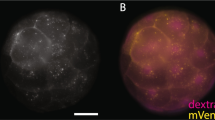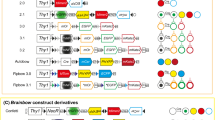Abstract
The thoracic ventral body wall consists of the rib, the sternum, the intercostal muscles, and the connective tissues surrounding them. The ribs and the intercostal muscles are derived from the somite. The connective tissues are derived from the somatic layer of the lateral plate mesoderm, somatopleure. The lateral growth of the somatopleure forms the primary ventral body wall. The migration of somitic cells into the somatopleure generates the secondary body wall. As the migrating behavior of the somatopleural cells during secondary body wall formation is still unclear, we investigate here the migratory behavior of the somatopleural cells in the thorax during chicken ventral body wall development by labeling the thoracic somatopleural cells one-somite-wide by DiI labeling or gene transfection of the enhanced green fluorescent protein and observe their distribution assisted by the tissue-clearing technique FRUIT. Our labeling experiments revealed the rostral migration of the somatopleural cells into a deep part of the thoracic body wall in embryonic day 6.5 chickens. For embryonic day 8.5 chickens, these deep-migrating somatopleural cells were found around the sternal ribs. Thus, we identified the double-layered two-directional migrating pathways of the somatopleural cells: the rostral migration of the deep somatopleural cells and the lateral migration of the superficial somatopleural cells. Our findings imply that the rostral migration of deep somatopleural cells and the lateral migration of superficial ones might be associated with the developing sternal ribs and the innervation of the thoracic cutaneous nerves, respectively.





Similar content being viewed by others
References
Aoyama H, Asamoto K (2000) The developmental fate of the rostral/caudal half of a somite for vertebra and rib formation: experimental confirmation of the resegmentation theory using chick-quail chimeras. Mech Dev 99:71–82. https://doi.org/10.1016/s0925-4773(00)00481-0
Aoyama H, Mizutani-Koseki S, Koseki H (2005) Three developmental compartments involved in rib formation. Int J Dev Biol 49:325–333. https://doi.org/10.1387/ijdb.041932ha
Bickley SR, Logan MP (2014) Regulatory modulation of the T-box gene Tbx5 links development, evolution, and adaptation of the sternum. Proc Natl Acad Sci USA 111:17917–17922. https://doi.org/10.1073/pnas.1409913111
Boylan M, Anderson MJ, Ornitz DM, Lewandoski M (2020) The FGF8 subfamily (FGF8, FGF17 and FGF18) is required for closure of the embryonic ventral body wall. Development. https://doi.org/10.1242/dev.189506
Burke AC, Nowicki JL (2003) A new view of patterning domains in the vertebrate mesoderm. Dev Cell 4:159–165. https://doi.org/10.1016/s1534-5807(03)00033-9
Casoni F, Malone SA, Belle M et al (2016) Development of the neurons controlling fertility in humans: new insights from 3D imaging and transparent fetal brains. Development 143:3969–3981. https://doi.org/10.1242/dev.139444
Chevallier A (1975) Rôle du mésoderme somitique dans le développement de la cage thoracique de l’embryon d’oiseau. I. Origine du segment sternal et mécanismes de la différenciation des côtes. J Embryol Exp Morphol 33:291–311
Chevallier A (1977) Origine des ceintures scapulaires et pelviennes chez l’embryon d’oiseau. J Embryol Exp Morphol 42:275–292
Christ B, Jacob M, Jacob HJ (1983) On the origin and development of the ventrolateral abdominal muscles in the avian embryo. an experimental and ultrastructural study. Anat Embryol (berl) 166:87–101. https://doi.org/10.1007/BF00317946
Duess JW, Puri P, Thompson J (2016) Impaired cytoskeletal arrangements and failure of ventral body wall closure in chick embryos treated with rock inhibitor (Y-27632). Pediatr Surg Int 32:45–58. https://doi.org/10.1007/s00383-015-3811-z
Dünker N, Krieglstein K (2002) Tgfbeta2 -/- Tgfbeta3 -/- double knockout mice display severe midline fusion defects and early embryonic lethality. Anat Embryol (berl) 206:73–83. https://doi.org/10.1007/s00429-002-0273-6
Evans DJ, Valasek P, Schmidt C, Patel K (2006) Skeletal muscle translocation in vertebrates. Anat Embryol (berl) 211(Suppl 1):43–50. https://doi.org/10.1007/s00429-006-0121-1
Fan H, Sakamoto N, Aoyama H (2018) From the primitive streak to the somitic mesoderm: labeling the early stages of chick embryos using EGFP transfection. Anat Sci Int 93:414–421. https://doi.org/10.1007/s12565-018-0429-y
Fogel JL, Lakeland DL, Mah IK, Mariani FV (2017) A minimally sufficient model for rib proximal-distal patterning based on genetic analysis and agent-based simulations. Elife. https://doi.org/10.7554/eLife.29144
Gómez-Gaviro MV, Balaban E, Bocancea D et al (2017) Optimized CUBIC protocol for three-dimensional imaging of chicken embryos at single-cell resolution. Development 144:2092–2097. https://doi.org/10.1242/dev.145805
Hamburger V, Hamilton HL (1951) A series of normal stages in the development of the chick embryo. J Morphol 88:49–92
Hirasawa T, Fujimoto S, Kuratani S (2016) Expansion of the neck reconstituted the shoulder-diaphragm in amniote evolution. Dev Growth Differ 58:143–153. https://doi.org/10.1111/dgd.12243
Honig MG, Camilli SJ, Surineni KM et al (2005) The contributions of BMP4, positive guidance cues, and repulsive molecules to cutaneous nerve formation in the chick hindlimb. Dev Biol 282:257–273. https://doi.org/10.1016/j.ydbio.2005.03.013
Hou B, Zhang D, Zhao S et al (2015) Scalable and DiI-compatible optical clearance of the mammalian brain. Front Neuroanat 9:19. https://doi.org/10.3389/fnana.2015.00019
Kardon G, Harfe BD, Tabin CJ (2003) A Tcf4-positive mesodermal population provides a prepattern for vertebrate limb muscle patterning. Dev Cell 5:937–944. https://doi.org/10.1016/s1534-5807(03)00360-5
Liem IK, Aoyama H (2009) Body wall morphogenesis: limb-genesis interferes with body wall-genesis via its influence on the abaxial somite derivatives. Mech Dev 126:198–211. https://doi.org/10.1016/j.mod.2008.11.003
Mekonen HK, Hikspoors JP, Mommen G et al (2015) Development of the ventral body wall in the human embryo. J Anat 227:673–685. https://doi.org/10.1111/joa.12380
Mich JK, Payumo AY, Rack PG, Chen JK (2014) In vivo imaging of Hedgehog pathway activation with a nuclear fluorescent reporter. PLoS ONE 9:e103661. https://doi.org/10.1371/journal.pone.0103661
Morrison JA, McKinney MC, Kulesa PM (2017) Resolving in vivo gene expression during collective cell migration using an integrated RNAscope, immunohistochemistry and tissue clearing method. Mech Dev 148:100–106. https://doi.org/10.1016/j.mod.2017.06.004
Nagashima H, Sugahara F, Watanabe K et al (2016) Developmental origin of the clavicle, and its implications for the evolution of the neck and the paired appendages in vertebrates. J Anat 229:536–548. https://doi.org/10.1111/joa.12502
Nichol PF, Corliss RF, Tyrrell JD et al (2011) Conditional mutation of fibroblast growth factor receptors 1 and 2 results in an omphalocele in mice associated with disruptions in ventral body wall muscle formation. J Pediatr Surg 46:90–96. https://doi.org/10.1016/j.jpedsurg.2010.09.066
Nichol PF, Corliss RF, Yamada S et al (2012) Muscle patterning in mouse and human abdominal wall development and omphalocele specimens of humans. Anat Rec (hoboken) 295:2129–2140. https://doi.org/10.1002/ar.22556
Nowicki JL, Takimoto R, Burke AC (2003) The lateral somitic frontier: dorso-ventral aspects of anterio-posterior regionalization in avian embryos. Mech Dev 120:227–240. https://doi.org/10.1016/s0925-4773(02)00415-x
Olivera-Martinez I, Coltey M, Dhouailly D, Pourquié O (2000) Mediolateral somitic origin of ribs and dermis determined by quail-chick chimeras. Development 127:4611–4617. https://doi.org/10.1242/dev.127.21.4611
Richardson DS, Lichtman JW (2015) Clarifying tissue clearing. Cell 162:246–257. https://doi.org/10.1016/j.cell.2015.06.067
Riento K, Ridley AJ (2003) Rocks: multifunctional kinases in cell behaviour. Nat Rev Mol Cell Biol 4:446–456. https://doi.org/10.1038/nrm1128
Sadler TW (2010) The embryologic origin of ventral body wall defects. Semin Pediatr Surg 19:209–214. https://doi.org/10.1053/j.sempedsurg.2010.03.006
Sato Y, Kasai T, Nakagawa S et al (2007) Stable integration and conditional expression of electroporated transgenes in chicken embryos. Dev Biol 305:616–624. https://doi.org/10.1016/j.ydbio.2007.01.043
Scaal M (2021) Development of the amniote ventrolateral body wall. Dev Dyn 250:39–59. https://doi.org/10.1002/dvdy.193
Schindelin J, Arganda-Carreras I, Frise E et al (2012) Fiji: an open-source platform for biological-image analysis. Nat Methods 9:676–682. https://doi.org/10.1038/nmeth.2019
Shearman RM, Tulenko FJ, Burke AC (2011) 3D reconstructions of quail-chick chimeras provide a new fate map of the avian scapula. Dev Biol 355:1–11. https://doi.org/10.1016/j.ydbio.2011.03.032
Snowball J, Ambalavanan M, Cornett B et al (2015) Mesenchymal Wnt signaling promotes formation of sternum and thoracic body wall. Dev Biol 401:264–275. https://doi.org/10.1016/j.ydbio.2015.02.014
Sudo H, Takahashi Y, Tonegawa A et al (2001) Inductive signals from the somatopleure mediated by bone morphogenetic proteins are essential for the formation of the sternal component of avian ribs. Dev Biol 232:284–300. https://doi.org/10.1006/dbio.2001.0198
Takahashi M, Tamura M, Sato S, Kawakami K (2018) Mice doubly deficient in Six4 and Six5 show ventral body wall defects reproducing human omphalocele. Dis Model Mech 11:dmm034611. https://doi.org/10.1242/dmm.034611
Takai A, Nakano M, Saito K et al (2015) Expanded palette of Nano-lanterns for real-time multicolor luminescence imaging. Proc Natl Acad Sci U S A 112:4352–4356. https://doi.org/10.1073/pnas.1418468112
Tian T, Yang Z, Li X (2021) Tissue clearing technique: recent progress and biomedical applications. J Anat 238:489–507. https://doi.org/10.1111/joa.13309
Watanabe T, Nakamura R, Takase Y et al (2018) Comparison of the 3-D patterns of the parasympathetic nervous system in the lung at late developmental stages between mouse and chicken. Dev Biol 444(Suppl 1):S325–S336. https://doi.org/10.1016/j.ydbio.2018.05.014
Acknowledgements
We thank the following people for kindly providing the plasmids: Y. Sato and Y. Takahashi for pCAGGS-T2TP, Y. Okada for pT2-7xTcf-NLS-CNL-CP (Addgene plasmid #65715), and J. Chen for 8xGliBS-IVS2-mCherry-NLS-polyA-Tol2 (Addgene plasmid #84604). Part of this study was supported by JSPS KAKENHI, grant number JP26460254. Part of this work was carried out at the Natural Science Center for Basic Research and Development, Hiroshima University.
Author information
Authors and Affiliations
Corresponding author
Ethics declarations
Conflict of interest
The authors declare that they have no conflict of interest.
Additional information
Publisher's Note
Springer Nature remains neutral with regard to jurisdictional claims in published maps and institutional affiliations.
Supplementary Information
Below is the link to the electronic supplementary material.
Supplementary file1 (AVI 80107 KB)
Supplementary file2 (AVI 84157 KB)
Rights and permissions
About this article
Cite this article
Sakamoto, N., Aoyama, H. & Ikegami, K. Double-layered two-directional somatopleural cell migration during chicken body wall development revealed with local fluorescent tissue labeling. Anat Sci Int 97, 380–390 (2022). https://doi.org/10.1007/s12565-022-00652-z
Received:
Accepted:
Published:
Issue Date:
DOI: https://doi.org/10.1007/s12565-022-00652-z




